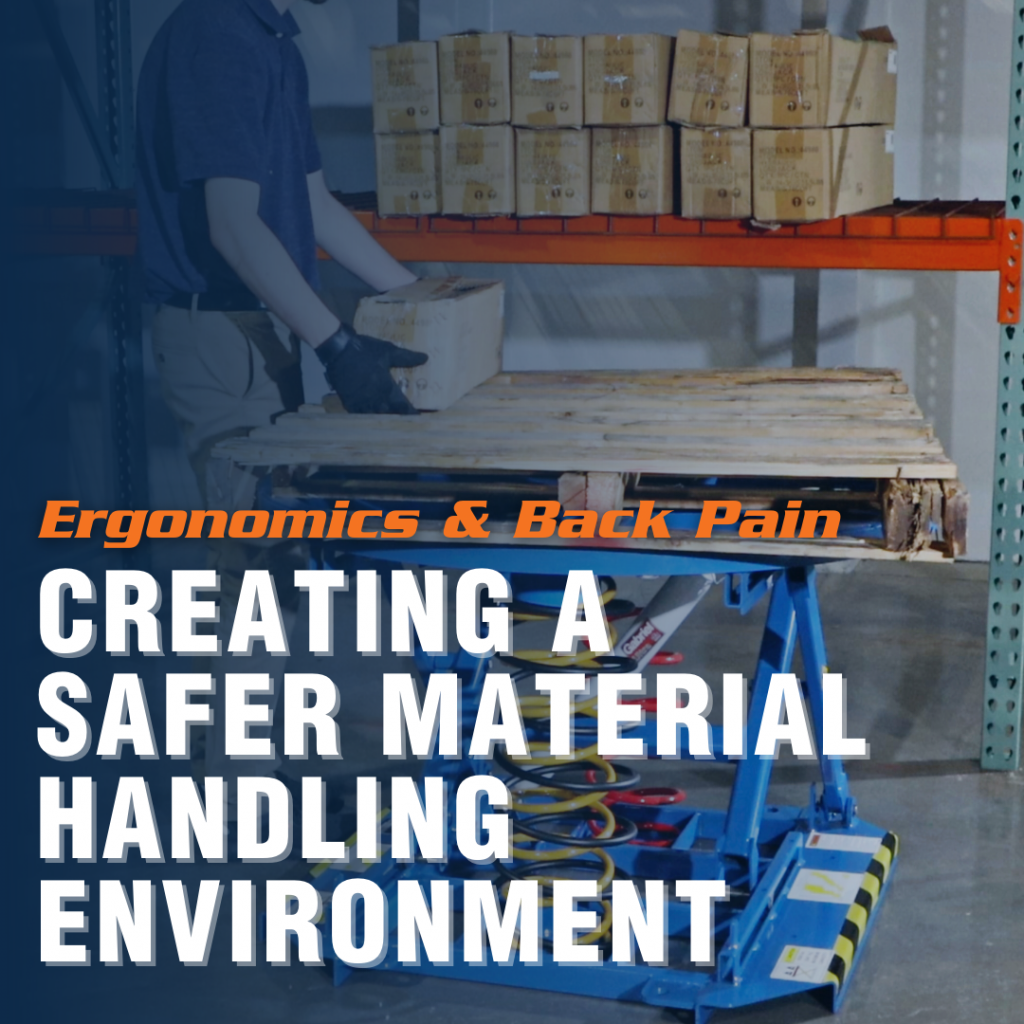We use cookies to make your experience better. To comply with the new e-Privacy directive, we need to ask for your consent to set the cookies. Learn more.
Ergonomics and Back Pain: Creating a Safer Material Handling Environment
Lifting, carrying, and repositioning materials is fundamental to many jobs. It’s the whole job for many workers in warehousing, construction, and manufacturing. And this basic task, without which industrial work cannot proceed, is hard on the human body—particularly the back, where force from upper body movements comes to rest.
The good news is that employers can take steps to improve ergonomics, and back pain rates among material handling staff tend to drop with proper ergonomic interventions. Here’s an introduction to the topic of ergonomics and back pain.

Work-Related Back Pain and Material Handling Risk Factors
Musculoskeletal disorders are injuries to muscles and the soft tissues that attach them to bones, including spinal discs. They’re caused by repetitive motion, force on the body, and awkward positions. These conditions are all associated with material handling, increasing the risk of work-related back pain for everyone involved in these tasks.
Back pain is the most commonly reported health problem caused by work, affecting 19.4 percent of respondents to one major survey. And it’s a particular risk for material handling staff. The Bureau of Labor Statistics looked at which parts of the body were affected by work-related musculoskeletal disorders in 2016. For material handling workers, the back was the most common location for musculoskeletal disorders requiring time off work, accounting for 43 percent of cases (compared to 38.5 percent for all occupations).
The effects of back pain can be devastating, and not just for the affected employees. Low back pain can lead to trouble with simple daily activities, from getting dressed to climbing stairs to cooking a meal, fracturing communities through associated isolation. It’s also a leading cause of disability and missed work, suggesting a powerful economic impact: Workers took an average of 9 days off for cases of lower back pain in 2020, according to Bureau of Labor Statistics data tools.
The key to reducing instances of back pain among material handling workers isn’t treatment; it’s prevention. And short of removing risky tasks entirely, ergonomics is the key to back-pain prevention.
Ergonomics and Back Pain: 5 Tips to Reduce the Risk
Ergonomics is the study of matching work to the worker, with the goal of preventing musculoskeletal disorders like the ones that lead to back pain. Here are a few ergonomic tips employers can follow to remove hazards associated with back pain in their material handling protocols.
1. Provide specialized carts to eliminate manual carrying from material streams.
Carrying heavy objects can strain the back. The simplest intervention is to remove the need for manual carrying, through the use of carts designed to match both specific materials and your broader material handling infrastructure.
To prevent warehouse back pain, choose Order Picking Carts that don’t require bending or stooping to operate. In retail environments, offer Stock Picking Carts with integrated step ladders, which prevent both carrying and awkward stretches. The key is to match the cart to the material—using a Cylinder Transporter to move heavy gas tanks, for instance.
2. Modify work placement to reduce reaching and bending, especially during lifts.
Reaching, bending, and stretching to access materials can stress muscles and soft tissues in the back (and elsewhere). That makes work placement—the physical location of materials workers access in relation to the worker’s body—an important consideration for reducing the risk of back pain.
Use Lift Tables to elevate materials for assembly or in preparation for lifting (avoid lifting from floor level wherever possible). When working with pallets, use platforms with rotating tables, like a Pallet Carousel & Skid Positioners—bringing materials to the worker, and not the other way around.
3. Use tipping equipment to prevent the need for awkward lifting and twisting while dumping containers.
Emptying containers is an ergonomically risky task, requiring a combination of lifting and twisting motions that can easily pull a back muscle. The solution is tipping equipment. For handling bulk bins, including garbage cans, provide Bin Dumpers, which handle the task from start to finish.
4. Introduce powered pushers/pullers to prevent back strain while moving heavily loaded carts.
Carts prevent manual carrying, which goes a long way toward reducing the back pain risk—but pushing and pulling heavy loads can also injure soft tissues in the back. The solution for heavily loaded carts is electric assistance: electric tuggers, pullers, and pushers that provide the force necessary to move heavy carts, without straining the user’s back.
5. Provide adjustable-height workstations for stationary work.
The National Institute of Occupational Safety and Health (NIOSH) identifies the distance between a worker’s shoulders and knees as the ergonomic “power zone.” Keeping work close to the body, within this range, limits back-stressing force, as well as limiting bending and reaching. Of course, every worker’s body is different—so to keep work within the power zone, employers must provide adjustable-height workstations like Lift Tables or Adjustable Packing Desks.
These tips are just an introduction to ergonomics, and back pain is far from the only risk factor. For help choosing specialized material handling equipment that creates a safer workplace, contact the BHS sales team at 1.800.BHS.9500.
